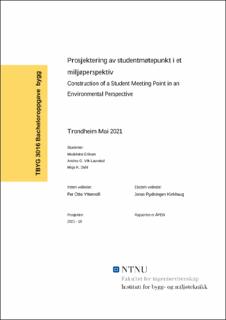| dc.contributor.advisor | Yttervoll, Per Otto | |
| dc.contributor.advisor | Kirkhaug, Jonas Rydningen | |
| dc.contributor.author | Eriksen, Madeleine | |
| dc.contributor.author | Lauvstad, Andrea O. Vik | |
| dc.contributor.author | Dahl, Maja K. | |
| dc.date.accessioned | 2021-09-20T16:30:13Z | |
| dc.date.available | 2021-09-20T16:30:13Z | |
| dc.date.issued | 2021 | |
| dc.identifier | no.ntnu:inspera:81154281:81155179 | |
| dc.identifier.uri | https://hdl.handle.net/11250/2779536 | |
| dc.description.abstract | Sammendrag
Denne bacheloroppgaven er utarbeidet på vegne av oppdragsgiver Asplan Viak, som et bidrag til forbildeprosjektet for bærekraftige studentboliger på Nardo i Trondheim. Oppgaven tar for seg prosjektering av en utendørs kaldkonstruksjon, hvor studentene kan samles for å koble av, sosialisere eller lese i grønnere omgivelser.
Prosjekteringen sikter mot å utforme et studentmøtepunkt, der det legges til rette for ombruk med utgangspunkt i FutureBuilts kriterier for sirkulære bygg. Sentralt ved prosjekteringen er dimensjonering av bærekonstruksjon i tre, samt utvalgte dekomponerbare forbindelser. Beregninger utføres i henhold til Norsk Standard. Ved dimensjonering benyttes også analyseverktøyet Focus Konstruksjon.
Ettersom et sentralt aspekt ved sirkulære prinsipper er reduksjon, vurderer oppgaven to aktuelle konstruktive løsninger opp mot hverandre. De konstruktive løsningene avveies etter dimensjonering av alternativenes bærende elementer. Vurderingen gjøres med utgangspunkt i et overordnet klimagassregnskap over opptredende materialmengder for sentrale komponenter.
Oppgaven stiller spørsmål til, og drøfter ulike tilnærminger til prosjektering for ombruk. Fordeler og ulemper ved de to alternativene drøftes også. For endelig løsning, dimensjoneres utvalgte forbindelser og nødvendige oppleggsflater. En detaljert 3D-modell utformes i BIM-verktøyet Archicad. 3D-modellen brukes videre som underlag for arbeidstegninger og utvalgte detaljtegninger.
Gjennom prosjekteringsprosessen har skillet til å bygge standardisert blitt tydelig. Prosjektering for ombruk er i tidlig fase basert på mange usikkerhetsmomenter, og krever kontinuerlig grundig avveide vurderinger og beslutninger. Denne prosessen er tid- og ressurskrevende, sett i sammenligning med standard prosjektering. Det ses med det på som helt avgjørende at veiledninger og standardiserte løsninger for gjenbruk blir utarbeidet, før en slik praksis vil utbres i bransjen. | |
| dc.description.abstract | Abstract
This bachelor thesis has been prepared on behalf of Asplan Viak, as a contribution to the ideal project for sustainable student housing at Nardo in Trondheim, Norway. The thesis compiles a design of an outdoor construction, where students can gather to relax, socialize, or read in a greener environment.
The design of the building structure aims at creating a construction which is facilitated for reuse, based on Criteria for circular buildings in FutureBuilt. The construction is designed as a meeting point for students. The dimensioning of a wooden superstructure is significant in the design of the building structure, as well as decomposable connections. Calculations are in accordance with Norwegian Standards. In addition, the analysis tool Focus Konstruksjon is used during the dimensioning.
As a key aspect in the circular principles is reduction, two current constructive alternatives are evaluated against each other. The alternatives get evaluated when the dimensioning of the load-bearing elements is completed. The assessment is based on the environmental impact, calculated by the quantities of material divergency for the key components in each alternative before a conclusion is made.
The thesis discus different approaches to design for reuse. The positive and negative attributes of the two alternatives are also discussed. For the final solution, selected connections and support surfaces are also dimensioned. A detailed 3D model is designed in the BIM tool Archicad. Further on, the 3D model is used as a basis for working drawings and selected detailed drawings.
During the process, the deviation of building standardized has become clear. Design for reuse is in the early stages based on many uncertainties and requires thoroughly weighed assessments and decisions. This process is time and resource consuming, compared to standard engineering. It is considered crucial, that guidelines and standardized solutions for reuse are compiled, before such procedures will be achieved in the major building industry. | |
| dc.language | nob | |
| dc.publisher | NTNU | |
| dc.title | Prosjektering av studentmøtepunkt i et miljøperspektiv | |
| dc.type | Bachelor thesis | |
